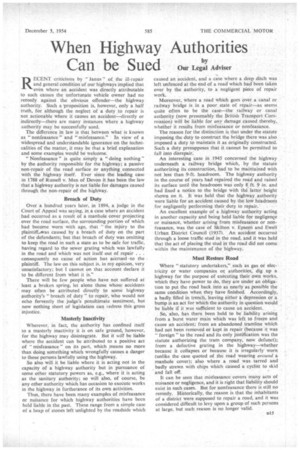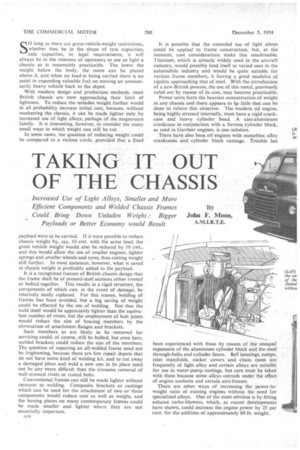When Highway Authorities
Page 55

Page 56

If you've noticed an error in this article please click here to report it so we can fix it.
Can be Sued Our Legal Adviser RECENT criticisms by " Janus " of, the ill-repair and general condition of our highways implied that even where an aceiderit was directly attributable to such causes the unfortunate vehicle owner had no remedy against the obvious offender—the highway authority. Such a proposition is, however, only a half truth, for although the neglect of a duty to repair is not actionable where it causes an accident—directly or indirectly—there are many instances where a highway authority may be successfully sued.
The difference in law is that between what is known as " nonfeasance " and "misfeasance." In view of a widespread and understandable ignorance on the technicalities of the matter, it may be that a brief explanation and some examples would be welcome.
" Nonfeasance " is quite simply a "doing nothing" by the authority responsible for the highway; a passive non-repair of the road surface or anything connected with the highway itself. Ever since the leading case in 1788 of Russell v. Men of Devon it has been the law that a highway authority is not liable for damages caused through the non-repair of the highway.
Breach of Duty Over a hundred years later, in 1894, a judge in the Court of Appeal was saying, in a case where an accident had occurred as a result of a manhole cover projecting over the road surface, the surrounding portion of which had become worn with age, that "the injury to the plaintiffowas caused by a breach of duty on the part of the defendants; but that breach of duty was omitting to keep the road in such a state as to be safe for traffic, having regard to the sewer grating which was lawfully in the road and which was not itself out of repair . . . consequently no cause of action has accrued to the plaintiff. The law on this subject is, in my opinion, very unsatisfactory; but I cannot on that account declare it to be different from what it is."
There will be few people who have not suffered at least a broken spring, let alone those whose accidents may often be attributed directly to some highway authority's " breach of duty" to repair, who would not echo fervently the judge's penultimate sentiment, but now nothing short of legislation can redress this gross injustice.
Masterly Inactivity Wherever, in fact, the authority has confined itself to a masterly inactivity it is on safe 'ground, however, for the highway may disintegrate. But it will be liable where the accident can be attributed to a positive act of " misfeasance" on its part, which .means no more than doing something which wrongfully causes a danger to those persons lawfully using the highway.
So also will it be liable where it is acting not in the capacity of a highway authority but in pursuance of some other statutory powers as, e.g., where it is acting as the sanitary authority; so will also, of course, be any other authority which has occasion to execute works in the highway, in furtherance of its own activities.
Thus, there have been many examples of misfeasance or nuisance for which highway authorities have been held liable in the past. These range from a simple case of a heap of stones left unlighted by the roadside which caused an accident, and a case where a deep ditch was left unfenced at the end of a road which had been taken over by the authority, to a negligent piece of repair work.
Moreover, where a road which goes over a canal or railway bridge is in a poor state of repair—as seems quite often to be the case—the railway or canal authority (now presumably the British Transport Commission) will be liable for any damage caused thereby, whether it results from misfeasance or nonfeasance.
The reason for the distinction is that under the statute imposing the duty to construct the bridge there was also imposed a duty to maintain it as originally constructed. Such a duty presupposes that it cannot be permitted to fall into disrepair.
An interesting case in .1945 concerned the highway underneath a railway bridge which, by the statute authorizing its construction, had to be maintained with not less than 9-ft. headroom. The highway authority in the.course of years had repaired the road and raised its surface until the headroom was only 8 ft. 9 in: and had fixed a notice to the bridge with the tatter height shown on it. It was held that the highway authority were liable for an accident caused by the low headroom for negligently performing their duty to repair. .
An excellent example of a highway authority acting in another capacity and being held liable for negligence or nuisance, whether arising from misfeasance or nonfeasance, was the case of Skilton v. Epsom and Ewell Urban District Council (1937). An accident occurred through a loose traffic stud in the road, and it was held that the act of placing the stud in the road did not come within the maintenance of the highway.
Must Restore Road
Where "statutory undertakers," such as gas or electricity or water companies or authorities: dig up a highway for the purpose of executing their own works, which they have power to do, they are under an obligation to put the road back into as nearly as possible the same condition when they have finished. Accordingly, a badly, filled in trench, leaving either a. depression or a bump is an act for which the authority in question would be liable if it was sufficient to cause an accident.
. So, also, has there been held to be liability arising from a burst water main which was left to freeze and cause an accident; from an abandoned .tramline which had not been removed or kept in repair (because it was " foreign " to the road and its only justification was the statute authorizing the tram company, now defunct); from a defective grating in the highway—whether because it collapses or because it is irregularly worn (unlike the case quoted of the road wearing around a manhole cover); also where a road was tarred and badly strewn with chips which caused a cyclist to skid and fall -off.
It can be seen that misfeasance covers many acts of nuisance or negligence, and it is right that liability should exist in such cases. But for nonfeasance there is still no remedy. Historically, the reason is that the inhabitants of a district were supposed to repair a road, and it was considered difficult to levy upon ,a group of such persons at large, but such reason is no longer valid.
SO long as there arc gross-vehicle-weight restrictions, whether they be in the shape of tyre capacities, axle capacities, or legal requirements, it will always be in the interests of operators to use as light a chassis as is reasonably practicable, The lower the weight below the body, the more can be placed above it, and when no load Is being carried there is no point in expending valuable fuel on moving an unnecessarily heavy vehicleback to the depot.
With modern design and production methods, most British chassis are now approaching their limit of lightness. To reduce the unladen weight further would in all probability increase initial cost, because, without weakening the chassis, it can be made lighter only by increased use of light alloys; perhaps of the magnesium family. It is interesting, however, to consider the many small ways in which weight can still be cut.
In some cases, the question of reducing weight could be compared to a vicious circle, provided that a fixed It is possible that the extended use of light alloys could be applied to frame construction, but, at the moment, cost considerations make this unadvisable. Titanium, which is already widely used in the aircraft industry, would possibly lend itself to varied uses in the automobile industry and would be quite suitable for various frame members, it having a good modulus of rigidity approaching that of steel. With the introduction of a new British process, the use of this metal, previously ruled out by reason of its cost, may become practicable.
Power units form the heaviest concentration of weight in any chassis and there appears to tr little that can be done to relieve this situation. The modern oil engine, being highly stressed internally, must have a rigid crankcase and heavy cylinder head. A cast-aluminium crankcase in conjunction with a ferrous cylinder block, as used in Gardner engines,-is one solution.
There have also been oil engines with mon.obloc alloy crankcases and. cylinder block Castings. Trouble has
















































































































